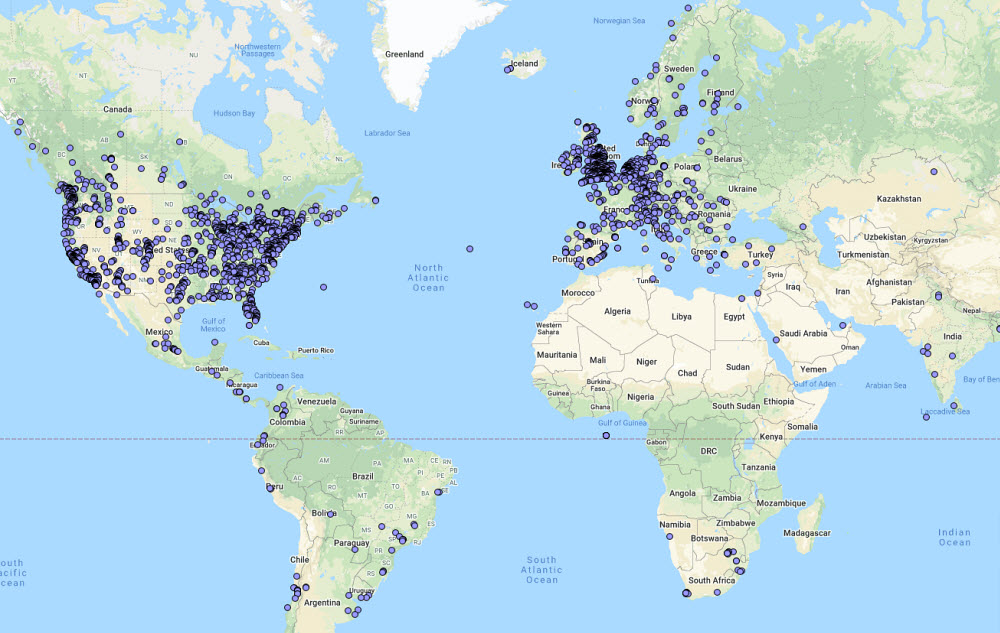
For the past nine years, residents of Windsor city, situated on the Canadian side of the US-Canada border just across Detroit river, have been complaining of a mysterious and persistent low-frequency humming noise. It comes and goes at random intervals, sometimes lasting hours and other times droning on for days. Those who can hear it—for not everyone can—compares the uncomfortable hum to an idling diesel engine or a pulsating subwoofer. Others say it sounds like a continuous distant thunder. Among those affected by the noise, some state the hum causes nausea and headache. Some have trouble sleeping. And yet for some, the hum is physically manifested by rattling windows and paintings knocking off the walls.
The Windsor hum has spurred many conspiracy theories from UFOs, to covert government projects. But studies point to a more mundane source—Zug island, an American industrial area located a few miles down the river at the southern city limits of Detroit. This area was originally a marsh land. But when a shipping canal was dug through in the late 1800s, excavated earth was piled up to form a patch of land, that later became an area of concentrated manufacturing and steel production. Zug island is currently occupied by a steel plant and a coke battery and a couple of blast furnaces.
Experts believe that the blast furnaces are responsible for the 35Hz noise that bathes the city of Windsor like a mystic fog. They observed the hum coincides with the appearance of bright blue flames on the islands’ exhaust stacks, which were easily seen from the Canadian shoreline at night. However, further study is nearly impossible because Zug island is private property and US Steel, who operates the furnaces, are uncooperative in any efforts at investigation.
Windsor isn’t the only place to be plagued by inexplicable rumbling sound. In the 1970s, hundreds of residents of Bristol, England, complained to the council that a strange, aggravating noise was audible at night. It was a low hum that only the most sensitive ears could pick, keeping some people awake at night. Most experts attributed it to factory noise or electricity pylons or a medical condition called tinnitus, where affected persons hear sounds when there is none. Before long, many other towns across Britain began reporting similar hums.
In the late 1980s, the coastal Scottish town of Largs began to experience the Hum. Residents who allegedly heard it described the noise being the loudest while indoors and at night. The hum was so loud that it triggered nosebleeds and chest pains in some. The reason why the sound appeared louder inside, a 1979 New Scientist article explained, was because of standing waves produced by reflection from the walls and ceilings.
In the US, the first outbreak of the Hum occurred in the town of Taos, in north-central New Mexico, in the early 1990s. Ten years later, the Indiana town of Kokomo caught the mysterious phenomenon. Here residents claimed that the Hum was so powerful it moved leaves on the ground and caused light bulbs to explode.
In each of these cases, the source of the noise was never positively identified.

Map of Hum sufferers around the world. Courtesy: Dr. Glen MacPherson
In 2015, a team of French scientists made a study of ocean waves and found that colliding waves can make the ocean floor vibrate generating seismic waves that can produce a low hum. The source can also be electromagnetic. Communication with submarines is often conducted using extremely low frequency radio waves with frequencies from 3 to 30Hz—low and strong enough to stimulate the auditory senses and induce throbbing headache in some.
The psychological effect of low frequencies on humans is well known. Exposure to low frequency sound waves has a negative effect on human cognitive performance, such as visual functions, concentration and attention. Numerous studies have shown that even when the noise is not audible, subjects show agitation, nervousness, apprehension, distraction, disappointment and psychological disorders, such as depression, stress, and irritability.
In 2012, a science teacher and former lecturer at the University of British Columbia, Dr. Glen MacPherson, began investigating the Hum after falling victim to it. MacPherson believes the Hum could have four possible sources—VLF radio frequencies between 3 Hz and 30 kHz that interacts with living tissue and the human auditory system in a way the brain interprets as sound; noise pollution generated by human activates such as mining, windmill farms, smelters and blast furnaces, freeway traffic, the electric grid, factories, etc.; terrestrial and geological processes such as earthquakes; and psychological.
Science writer Benjamin Radford explains the psychological part.
The Hum mystery may be found in the inner world of personal experience instead of the outer world of factories and heavy equipment. What does your tongue taste like? What does your nose smell like? What does your ear sound like? These are not silly, simple questions but instead may hold part of the answer.
Even though we don't notice it, our ears sometimes create their own noises. And because the sounds are subtle (and because most people are constantly surrounded by sound, whether it's music, television, video games, or just a typical noisy city life) we don't hear them until it's very quiet or we are listening carefully. This phenomenon, called spontaneous otoacoustic emissions, is different than auditory disorders such as tinnitus, which causes a ringing in the ears. It might explain some of the "hearers" reports.
MacPherson made a World Hum Map and Database, an interactive website where Hum sufferers can report hearings. Till date, there has been over 3,000 submissions from around the world, centered mostly around the US and western Europe. He estimates that up to 4 percent of people worldwide can hear the Hum.
Leading image by Roman Samborskyi/Shutterstock.com
References:
# The Guardian, https://www.theguardian.com/world/2016/jun/07/windsor-hum-canada-zug-island-united-states
# Arstechnica, https://arstechnica.com/science/2018/02/a-mysterious-and-maddening-hum-is-tormenting-residents-of-this-canadian-city/
# Live Science, https://www.livescience.com/43519-taos-hum.html
# HG Leventhall, http://www.noiseandhealth.org/article.asp?issn=1463-1741;year=2004;volume=6;issue=23;spage=59;epage=72;aulast=Leventhall
# Phy.org, https://phys.org/news/2015-04-source-earth-french-team-views.html
# The Guardian, https://www.theguardian.com/cities/2019/mar/13/what-is-the-mysterious-gl-hum-and-is-it-simply-noise-pollution
# https://www.ncbi.nlm.nih.gov/pubmed/16201210
# New Scientist, https://books.google.co.in/books?id=66VHTgzbIEUC&lpg=PP1&pg=PA868&redir_esc=y#v=onepage&q&f=false



Comments
Post a Comment